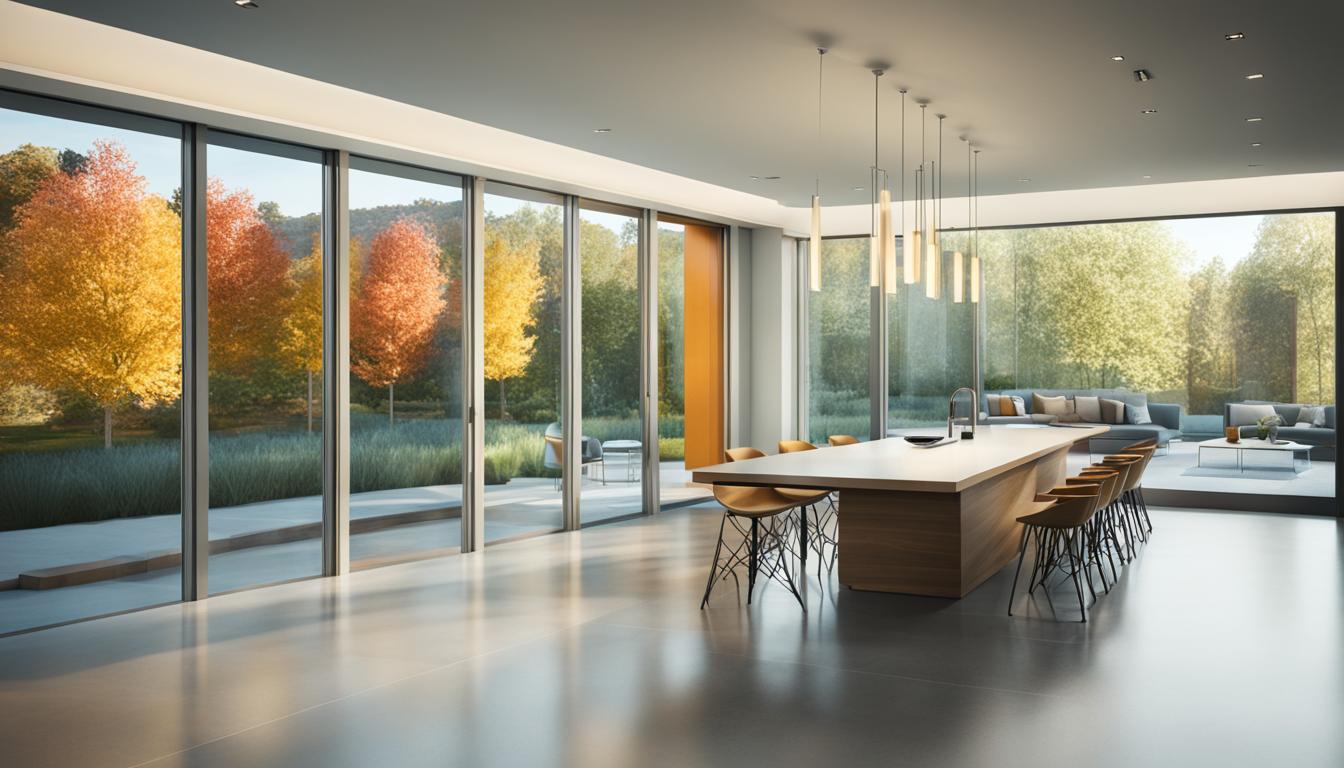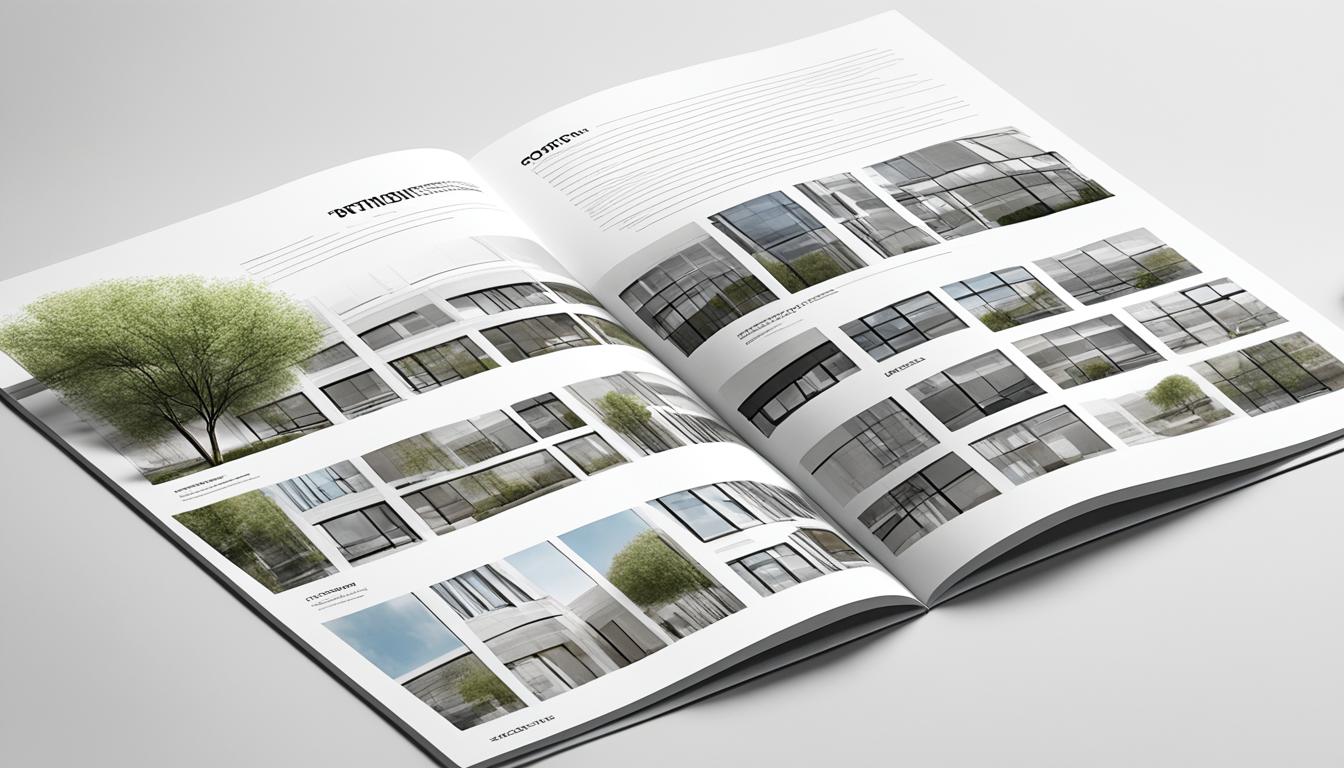When it comes to architectural design, harnessing light is a powerful tool that can transform spaces and create a truly captivating experience. Whether it’s working with natural light sources or utilizing artificial lighting techniques, architects and designers have the ability to enhance the aesthetics, functionality, and ambiance of a building through creative lighting design.
Architectural lighting is an integral part of the design process, encompassing both natural and artificial light sources. From carefully positioning windows to incorporating innovative lighting systems, the goal is to create spaces that are not only well-lit but also visually appealing and conducive to the occupants’ well-being.
Key Takeaways:
- Natural and artificial light can be harnessed and combined to enhance spaces in architecture.
- Architectural lighting involves working with both natural and artificial light sources.
- Lighting design plays a crucial role in creating visually appealing and functional spaces.
- Strategic placement of windows and innovative lighting techniques can transform the ambiance of a building.
- Creative lighting design can enhance occupant well-being and create captivating environments.
Remote-controlled Sunlight: How Smart Technology is Revolutionizing Illumination in Buildings
When it comes to lighting buildings, remote-controlled sunlight powered by smart technology is revolutionizing the industry. This innovative approach allows buildings to harness natural daylight as the primary source of light, reducing the reliance on artificial lighting and resulting in significant energy savings and a reduced carbon footprint.
Studies have shown that incorporating proper daylight integration can reduce energy consumption for lighting by up to 60%. By utilizing remote-controlled sunlight, buildings can maximize energy efficiency and achieve sustainable lighting solutions.
One of the key advantages of smart technology is its ability to provide adaptive illumination. Smart lighting systems automatically adjust lighting levels based on occupancy and natural light variations, ensuring optimal lighting conditions at all times. This not only enhances energy efficiency but also creates a comfortable and productive environment for occupants.
Take a look at the following table to understand the potential lighting savings achieved through remote-controlled sunlight:
| Building Type | Energy Savings |
|---|---|
| Residential | Up to 50% |
| Commercial | Up to 60% |
| Industrial | Up to 70% |
As you can see from the table, the potential energy savings vary depending on the building type, but they demonstrate the significant impact remote-controlled sunlight can have on reducing energy consumption and promoting sustainability.
By embracing remote-controlled sunlight and smart lighting technology, buildings can achieve not only energy efficiency and cost savings but also contribute to a greener future through sustainable lighting practices.
Key Benefits of Remote-controlled Sunlight:
- Significant energy savings
- Reduced carbon footprint
- Improved occupant comfort and productivity
- Optimal lighting conditions at all times
- Enhanced sustainability and eco-friendly practices
“Remote-controlled sunlight coupled with smart technology is transforming the way buildings are illuminated, paving the way for energy-efficient and sustainable lighting solutions.” – Lighting Design Expert
Solar-powered Skylights: A Bright Solution for Energy-efficient Buildings
Solar-powered skylights are revolutionizing the way buildings harness natural light and promote energy efficiency. With a focus on renewable energy and sustainable building practices, these innovative roof windows leverage the power of the sun to provide a range of benefits, including energy savings, ample natural light, improved ventilation, and easy installation without the need for additional wiring.
Equipped with built-in solar panels, solar-powered skylights convert sunlight into electricity, powering motorized functions such as opening and closing. This integration of renewable energy not only reduces reliance on artificial lighting but also lowers energy consumption, resulting in significant cost savings and a reduced carbon footprint.
One of the primary advantages of solar-powered skylights is the abundance of natural light they bring into buildings. By harnessing the sun’s rays, these skylights flood interiors with natural light, creating a more welcoming and productive environment for occupants. The bright and airy atmosphere enhances well-being, boosts mood, and improves overall comfort.
In addition to natural light, solar-powered skylights also provide improved ventilation. With the ability to open and close, these skylights facilitate airflow and fresh air circulation, reducing the reliance on mechanical ventilation systems and further enhancing energy efficiency.
The installation of solar-powered skylights is a sustainable building practice that aligns with the principles of environmentally conscious design. By utilizing renewable energy and reducing energy consumption, buildings contribute to a greener future while providing comfortable and well-lit spaces for occupants.
Here are some key advantages of incorporating solar-powered skylights:
- Energy savings through the utilization of renewable energy sources
- Ample natural light for a bright and inviting interior
- Improved ventilation and fresh air circulation
- Easy installation without additional wiring

| Features | Solar-powered Skylights | Traditional Skylights |
|---|---|---|
| Energy Efficiency | Powered by the sun, reducing reliance on artificial lighting | Relies solely on natural light |
| Ventilation | Motorized functions for improved airflow | Static, limited airflow |
| Installation | Easy installation without additional wiring | May require additional electrical work |
| Cost | Potential energy savings over time | Lower upfront costs |
Natural Light Optimization Design Strategies for Sun-drenched Interiors
Optimizing natural light in sun-drenched interiors can greatly enhance the visual appeal and functionality of spaces. Strategic window placement and sizing help capture and distribute natural light effectively. Other design strategies, such as the use of light shelves, sun control devices, and glare reduction techniques, further optimize natural light while maintaining visual comfort. These strategies ensure that spaces are well-lit, reduce reliance on artificial lighting, and create a pleasant environment for occupants.
When it comes to natural light optimization, window placement is of utmost importance. By strategically positioning windows, architects can maximize the intake of natural light, allowing it to flow deep into the interiors. In sun-drenched spaces, windows should be located to capture the most sunlight while minimizing heat gain. Additionally, incorporating larger windows or floor-to-ceiling glazing can create a seamless connection between the indoors and outdoors, flooding the space with natural light.
Light shelves are another effective strategy for optimizing natural light. These horizontal surfaces, installed above eye level, bounce sunlight towards the ceiling, creating a diffuse and evenly distributed glow. This technique maximizes daylight penetration while reducing direct sunlight and glare. Light shelves are particularly beneficial in sun-drenched interiors where excessive brightness and glare may be an issue.
Sun control devices, such as exterior shading systems and louvers, play a crucial role in optimizing natural light. These devices help regulate the amount of sunlight entering the space, preventing overheating and reducing the need for excessive artificial lighting. By controlling the intensity and direction of sunlight, they ensure a comfortable and well-balanced lighting environment.
Glare reduction techniques are essential for maintaining visual comfort in sun-drenched interiors. Glare occurs when excessive brightness causes discomfort or impairs visibility. To mitigate glare, architects can incorporate features such as diffusing materials, tinted glass, and adjustable blinds or curtains. These elements help to soften and diffuse the incoming light, creating a more pleasant and glare-free environment.
Natural light optimization in sun-drenched interiors is a delicate balance between maximizing daylight, reducing glare, and maintaining occupant comfort. Strategic window placement, light shelves, sun control devices, and glare reduction techniques are key elements in creating well-lit, visually appealing spaces that enhance occupants’ well-being.
Benefits of Natural Light Optimization
Optimizing natural light offers numerous benefits beyond energy efficiency and reduced reliance on artificial lighting. Here are some advantages:
- Enhanced Visual Comfort: Natural light creates a sense of well-being and improves visual clarity, reducing eye strain and fatigue.
- Connection to the Outdoors: Sun-drenched interiors with ample natural light create a seamless connection between indoor and outdoor environments, enhancing the overall aesthetic appeal.
- Health and Productivity: Exposure to natural light has been linked to improved mood, increased productivity, and better overall psychological well-being.
- Sustainable Design: By reducing the need for artificial lighting, natural light optimization contributes to energy efficiency and sustainable building practices.
Case Study: The Sunlit Oasis Hotel
To illustrate the effectiveness of natural light optimization strategies, let’s take a look at the Sunlit Oasis Hotel. Designed by renowned architect Sophia Miller, this luxurious hotel maximizes the use of natural light to create a serene and inviting atmosphere.
| Design Features | Benefits |
|---|---|
| Strategic Window Placement | Captures abundant natural light while minimizing heat gain |
| Light Shelves | Redirects sunlight towards the ceiling, creating a diffuse glow and reducing glare |
| Sun Control Devices | Regulates the amount of sunlight entering the space, ensuring optimal lighting conditions |
| Glare Reduction Techniques | Softens and diffuses incoming light, creating a comfortable and glare-free environment |
By incorporating these natural light optimization strategies, the Sunlit Oasis Hotel provides a tranquil and visually stunning experience for its guests. The thoughtful integration of natural light not only enhances the hotel’s aesthetic appeal but also promotes a sense of well-being and sustainable design.
Illuminating the Future: Why Natural Lighting is a Key Element in Sustainable Architecture
Natural lighting plays a vital role in sustainable architecture, offering numerous benefits. By incorporating natural light sources such as windows, skylights, and light tubes, buildings can significantly reduce energy consumption for lighting purposes. This improves energy efficiency, lowers utility costs, and reduces the carbon footprint.
Additionally, natural lighting positively impacts occupant well-being, enhancing productivity, mood, and overall health. Exposure to natural light has been proven to regulate circadian rhythms and promote better sleep quality. It also provides essential vitamin D synthesis, boosting immune function and bone health.
Moreover, natural lighting adds an aesthetic value to architectural design, creating visually appealing spaces that connect with the surrounding environment. The interplay of light and shadow adds depth and dimension to interiors, enhancing the overall aesthetic appeal of a space.
To further illustrate the importance of natural lighting in sustainable architecture, take a look at the table below:
| Benefits of Natural Lighting in Sustainable Architecture | |
|---|---|
| Energy Efficiency | Natural lighting reduces reliance on artificial lighting, lowering energy consumption and utility costs. |
| Occupant Well-being | Natural light exposure enhances mood, productivity, and overall health. |
| Aesthetic Appeal | Natural lighting creates visually appealing spaces that blend harmoniously with the environment. |
As the table shows, integrating natural lighting into sustainable architecture promotes a greener and more sustainable future, benefitting both the environment and the occupants of the building.
Combining the functional aspects of energy efficiency with the holistic benefits to occupant well-being and aesthetic appeal, natural lighting emerges as a key element in contemporary architecture, transforming spaces into sustainable and inviting environments.

From Daylight to Moonlight: Exploring Innovative Natural Lighting Solutions for Buildings
Natural lighting solutions for buildings go beyond daylighting. Innovations such as smart glass, solar tubes, and smart skylights are transforming the way buildings are illuminated.
Smart glass allows for the control of light transmission and privacy electronically, optimizing daylight while minimizing glare and heat gain. With a simple switch or a smart home automation system, you can adjust the transparency of the glass, making it an ideal solution for both residential and commercial buildings. This advanced technology enhances energy efficiency by optimizing natural light levels, reducing the need for artificial lighting during the day.
Solar tubes are an ingenious way to bring natural light into interior spaces with limited access to windows. By capturing sunlight on the roof and redirecting it into reflective tubing, solar tubes illuminate areas that would otherwise rely solely on artificial lighting. Whether it’s a small bathroom or a windowless hallway, solar tubes provide a sustainable and cost-effective lighting source.
“Solar tubes bring natural light to areas of the home that were previously dark and uninviting. It’s incredible how they transform the space, making it feel brighter and more welcoming.” – John Anderson, Architect
Smart skylights offer dynamic control over light levels, adjusting to external conditions for optimal energy efficiency and user comfort. Equipped with built-in sensors, these skylights can automatically open and close to adjust the amount of daylight entering the space. In addition, they can be operated manually using a remote control or integrated with a smart home system for seamless control. Smart skylights not only provide ample natural light but also contribute to the overall aesthetic and functionality of a building.
To create serene and enchanting nighttime atmospheres, designers can incorporate the concept of moonlighting. This technique involves placing low-voltage lights in strategic locations to mimic the soft and ethereal qualities of moonlight. Moonlighting can be used both indoors and outdoors, creating a peaceful ambiance and highlighting architectural features.
With these innovative natural lighting solutions, buildings can optimize energy efficiency, enhance aesthetic appeal, and promote a healthier living and working environment.
Balancing Natural Light and Energy Efficiency in Building Design
In building design, we understand the importance of striking a balance between natural light and energy efficiency. By harnessing natural light, we can reduce the need for artificial lighting, resulting in lower energy consumption, reduced utility bills, and a smaller carbon footprint.
But the benefits of natural light go beyond energy savings. Sunlight has a profound impact on our psychological and physical well-being. Exposure to natural light has been shown to improve mood, increase productivity, and promote overall health. By incorporating ample natural light in building design, we can create spaces that support the well-being of occupants.
Daylighting: Enhancing Spaces with Natural Light
Daylighting is a design strategy that focuses on maximizing the use of natural light in a building. By strategically placing windows, skylights, and light tubes, we can optimize the amount of sunlight entering a space.
Daylighting not only reduces the need for artificial lighting during the day but also enhances the visual appeal of interiors. The play of natural light and shadow creates depth and dimension, adding a sense of beauty and liveliness to a space.
“Daylight is the most abundant and energy-efficient light source available.”
In addition to aesthetic benefits, daylighting contributes to energy efficiency and sustainability. By relying less on artificial lighting, we reduce energy consumption and lessen the environmental impact. This aligns with the principles of passive solar design, which utilizes the sun’s energy for heating and cooling spaces. By integrating passive solar design into building systems, we can further enhance energy efficiency and create more sustainable environments.
Bringing Nature Indoors: Biophilic Design
Biophilic design is a concept that recognizes and embraces the innate human connection to nature. By incorporating natural elements, such as plants, water features, and natural materials, we can create spaces that promote well-being and improve the overall human experience.
Daylighting plays a crucial role in biophilic design by bringing the beauty and vitality of the outdoors into our built environments. The presence of natural light and views to the outside world evoke a sense of calm and connection to nature. This connection has been proven to enhance cognitive function, creativity, and overall satisfaction with the space.
The Power of Collaboration: Integrating Natural Light and Energy Efficiency
Successfully balancing natural light and energy efficiency requires collaboration among architects, lighting designers, and energy consultants. By working together, we can devise comprehensive strategies that optimize both natural and artificial lighting systems.
Intelligent lighting controls, such as dimming systems and occupancy sensors, can be integrated with natural light sources to achieve optimal lighting levels while minimizing energy consumption. This ensures that spaces are adequately illuminated while still maintaining energy efficiency.
“A well-designed space should seamlessly integrate natural and artificial lighting, providing a harmonious environment for occupants.”
When considering building design, it is vital to prioritize the interplay between natural light and energy efficiency. By striking this balance, we can create spaces that are visually appealing, promote occupant well-being, and contribute to a more sustainable future.
Conclusion
In conclusion, the integration of natural and artificial light in architecture presents a multitude of opportunities for enhancing spaces and creating sustainable buildings. By harnessing technologies such as remote-controlled sunlight, solar-powered skylights, and innovative lighting solutions, we can achieve both energy efficiency and aesthetic appeal.
By leveraging natural light sources and reducing reliance on artificial lighting, we can lower energy consumption and reduce our carbon footprint. This not only benefits the environment but also contributes to more sustainable architecture. The use of natural light promotes occupant well-being, improves productivity, and creates visually appealing spaces that connect with the surrounding environment.
Incorporating natural lighting into building design requires careful consideration of factors such as window placement, daylighting strategies, and glare reduction techniques. Balancing natural light and energy efficiency ensures optimal functionality and visual comfort for occupants. By achieving this balance, we can create spaces that are not only visually stunning but also environmentally friendly.
The future of lighting in architecture is bright, with endless possibilities for creativity and innovation. By embracing the potential of natural and artificial light, we can continue to enhance the way we illuminate our buildings, creating sustainable and welcoming spaces for generations to come.
FAQ
What are some strategies for reducing energy consumption in lighting buildings?
One strategy is to leverage natural daylight as a primary light source, reducing reliance on artificial lighting. Other strategies include using energy-efficient light sources, implementing smart lighting systems, and optimizing natural light through strategic window placement and sizing.
How can remote-controlled sunlight revolutionize illumination in buildings?
Remote-controlled sunlight, enabled by smart technology, allows buildings to utilize natural daylight as a primary light source. This reduces energy consumption for lighting, resulting in significant energy savings and a reduced carbon footprint. Smart lighting systems also offer adaptive illumination, automatically adjusting lighting levels based on occupancy and natural light variations.
What are the advantages of using solar-powered skylights in buildings?
Solar-powered skylights offer several benefits, such as energy savings, ample natural light, improved ventilation, and easy installation without the need for additional wiring. These specially designed roof windows utilize the power of the sun to provide natural light and reduce reliance on artificial lighting.
How can natural light be optimized in sun-drenched interiors?
Natural light can be optimized in sun-drenched interiors through strategic window placement and sizing. Design strategies like light shelves, sun control devices, and glare reduction techniques can further enhance natural light while maintaining visual comfort.
What are the benefits of incorporating natural lighting in sustainable architecture?
Incorporating natural lighting in sustainable architecture offers numerous benefits, including energy efficiency, lower utility costs, reduced carbon footprint, improved occupant well-being, enhanced productivity, and aesthetic value to architectural design.
What are some innovative natural lighting solutions for buildings?
Innovations such as smart glass, solar tubes, and smart skylights are transforming the way buildings are illuminated. Smart glass allows for the control of light transmission and privacy electronically, while solar tubes capture sunlight on the roof and redirect it into interior spaces through reflective tubing. Smart skylights offer dynamic control over light levels, adjusting to external conditions for optimal energy efficiency and user comfort.
How can natural light and energy efficiency be balanced in building design?
Balancing natural light and energy efficiency in building design involves harnessing natural light to reduce the need for artificial lighting, incorporating passive solar design, and carefully considering the interplay between natural light and energy consumption. This not only improves energy efficiency but also enhances visual comfort and overall sustainability.
How Can Tilt-Shift Photography Enhance the Use of Light in Architecture?
Tiltshift architectural photography techniques can enhance the use of light in architecture by creating a unique perspective. By selectively focusing on certain areas, the technique can draw attention to elements that may be overlooked. This can result in a more dynamic and visually appealing representation of architectural spaces.




